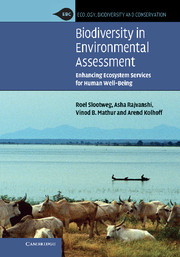Book contents
- Frontmatter
- Contents
- List of contributors
- Foreword
- Preface
- List of abbreviations
- Part I Setting the stage
- Part II Assessment tools
- Part III Emerging issues
- 8 Reconciling conservation and development: the role of biodiversity offsets
- 9 Valuation of ecosystem services: lessons from influential cases
- Epilogue – Topics in need of further elaboration
- Annex: valuation of ecosystem services: influential cases
- References
- Index
8 - Reconciling conservation and development: the role of biodiversity offsets
Published online by Cambridge University Press: 05 July 2014
- Frontmatter
- Contents
- List of contributors
- Foreword
- Preface
- List of abbreviations
- Part I Setting the stage
- Part II Assessment tools
- Part III Emerging issues
- 8 Reconciling conservation and development: the role of biodiversity offsets
- 9 Valuation of ecosystem services: lessons from influential cases
- Epilogue – Topics in need of further elaboration
- Annex: valuation of ecosystem services: influential cases
- References
- Index
Summary
Background
Many of the efforts of the global conservation community are directed to achieve two seemingly incompatible goals – biodiversity conservation and economic development. The synchronization of efforts for achieving these conflicting goals is often hampered by multiplicity of factors that threaten biodiversity. Those threats to biodiversity that are driven by an increasing array of homogenizing forces include at least three factors. First, there is the spread of introduced species (Mack et al., 2000). Second, there are increasing demands on biodiversity resources due to dominance of humans as principle components of natural ecosystems (Putz, 1998; Sanderson et al., 2002) in most biodiversity-rich countries. Third, there is the rising impact of competing land uses in wilderness areas for meeting contrasting objectives of satisfying the socioeconomic needs of the human population and conserving the fast declining diversity and decreasing sizes of populations of species. The increasing trends of habitat fragmentation, modification, and loss of forests, wetlands, coral reefs, and other ecosystems resulting from unabated and accelerating transformation of the earth for urban development, perhaps remain the single most pervasive threat to biodiversity resources (Sala et al., 2000; McNeely, 2006).
Biodiversity conservation has a number of distinguishing features which differentiate it from more conventional resource management issues and which must be taken into account in implementing development projects. Some of the biodiversity losses may be irreversible, and once lost, a species is gone forever. Also, many species, especially invertebrates, microbes and viruses, have yet to be discovered. Therefore much of the biodiversity loss that is presently occurring is in the form of loss of species we have yet to discover (Young et al., 1996). Stopping developments cannot always be an answer. Moving beyond the environment versus development debates and making a fresh resolve to mainstream biodiversity in development may perhaps lead to more positive efforts towards a sustainable future.
- Type
- Chapter
- Information
- Biodiversity in Environmental AssessmentEnhancing Ecosystem Services for Human Well-Being, pp. 255 - 286Publisher: Cambridge University PressPrint publication year: 2009



